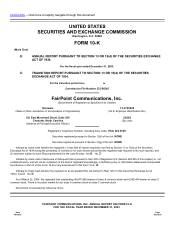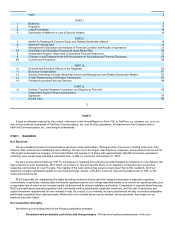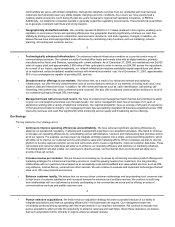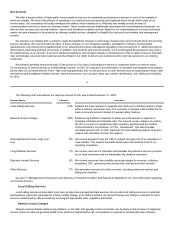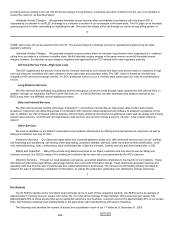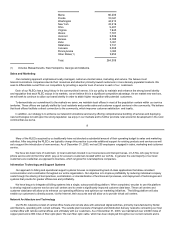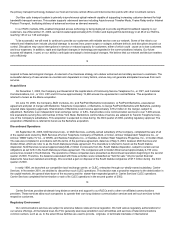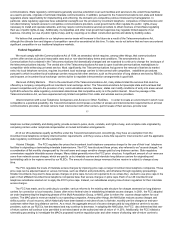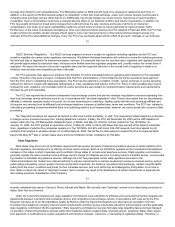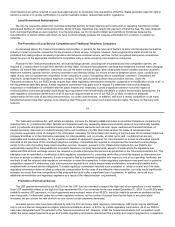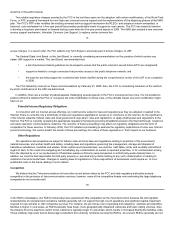FairPoint Communications 2003 Annual Report Download - page 4
Download and view the complete annual report
Please find page 4 of the 2003 FairPoint Communications annual report below. You can navigate through the pages in the report by either clicking on the pages listed below, or by using the keyword search tool below to find specific information within the annual report.
We offer a broad portfolio of high-quality communications services for residential and business customers in each of the markets in
which we operate. We have a long history of operating in our markets and a recognized and respected brand identity within each of our
service areas. Our companies are locally managed and staffed, which enables us to efficiently and reliably provide an array of
communications services to meet our customer needs. These include services traditionally associated with local telephone companies, as
well as other services such as long distance, Internet and broadband enabled services. Based on our understanding of our local customers'
needs, we have attempted to be proactive by offering bundled services designed to simplify the customer's purchasing and management
process.
We operate in an industry that is subject to rapid and significant changes in technology, frequent new service introductions and evolving
industry standards. We cannot predict the effect of these changes on our competitive position, profitability or industry. Technological
developments may reduce the competitiveness of our networks and require unbudgeted upgrades or the procurement of additional products
that could be expensive and time consuming. In addition, new products and services arising out of technological developments may reduce
the attractiveness of our services. If we fail to adapt successfully to technological changes or obsolescence or fail to obtain access to important
new technologies, we could lose customers and be limited in our ability to attract new customers and/or sell new services to our existing
customers.
We primarily generate revenue through: (i) the provision of our basic local telephone service to customers within our service areas;
(ii) the provision of network access to interexchange carriers, or IXCs, for origination and termination of interstate and intrastate long distance
phone calls; (iii) Universal Service Fund—high cost loop payments; and (iv) the provision of other services such as long distance resale, data
and Internet and broadband enabled services, enhanced services, such as caller name and number identification, and billing and collection
for IXCs.
5
The following chart summarizes our revenue sources for the year ended December 31, 2003:
Local Calling Services 24%Enables the local customer to originate and receive an unlimited number of calls
within a defined "exchange" area. The customer is charged a flat monthly fee for
basic service and service charges for special calling features.
Network Access Charges 48%Enables long distance companies to utilize our local network to originate or
terminate intrastate and interstate calls. The network access charges are paid by
the IXC to us and are regulated by state regulatory agencies and the Federal
Communications Commission, or FCC, respectively. This also includes
universal service fund, or USF, payments for local switching support, long term
support and interstate common line support.
Universal Service Fund—high cost
loop
8% We receive payments from the USF to support the high cost of our operations in
rural markets. This support fluctuates based upon the historical costs of our
operating companies.
Long Distance Services 7% We receive revenues for intrastate and interstate long distance services provided
to our retail customers and our wholesale long distance customers.
Data and Internet Services 6% We receive revenues from monthly recurring charges for services, including
broadband, DSL, special access, private lines, Internet and other services.
Other Services 7% We generate revenues from other services, including enhanced services and
billing and collection.
See Item 7 "Management's Discussion and Analysis of Financial Condition and Results of Operations" for more information regarding
our revenue sources.
Local calling services include basic local lines, private lines and switched data services. We provide local calling services to residential
and business customers, generally for a fixed monthly charge. In an RLEC's territory, the amount that we can charge a customer for local
service is determined by rate proceedings involving the appropriate state regulatory authorities.
Network access charges relate to long distance, or toll calls, that typically involve more than one company in the provision of telephone
service. Since toll calls are generally billed to the customer originating the call, a mechanism is required to compensate each company

